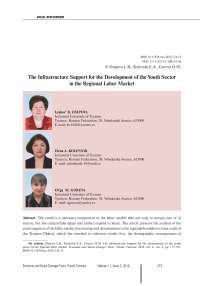The infrastructure support for the development of the youth sector in the regional labor market
Автор: Osipova Lyubov B., Kolesnik Elena A., Goreva Olga M.
Журнал: Economic and Social Changes: Facts, Trends, Forecast @volnc-esc-en
Рубрика: Social development
Статья в выпуске: 2 (56) т.11, 2018 года.
Бесплатный доступ
The youth is a necessary component in the labor market able not only to occupy one of its sectors, but also successfully adapt and further expand its share. The article presents the analysis of the youth segment of the labor market functioning and development in the regional breakdown (case study of the Tyumen Oblast), which has revealed its inherent trends: first, the demographic consequences of the decline in the number of young people; second, the asymmetry in the received information; third, institutional imbalances characterized by uneven supply and demand; and fourth, hidden unemployment. These problems are significant barriers limiting the development of the youth sector of the labor market. The hypothesis is the assumption that the development of the youth sector of the labor market and successful inclusion of the youth in the system of social and labor relations can be facilitated by the developed system of infrastructure support that can create favorable conditions for professional fulfilment of young people...
Social group, youth, labor market, labor market sector, labor market infrastructure
Короткий адрес: https://sciup.org/147224036
IDR: 147224036 | УДК: 331.5-053.81 | DOI: 10.15838/esc.2018.2.56.12
Текст научной статьи The infrastructure support for the development of the youth sector in the regional labor market
Introduction. Globalization of the world’s economy requires a new understanding of conceptual provisions on the labor market, the role of the state in its regulation. The features of formation, modern condition and development prospects for the domestic employment market are becoming more acute in public life [9; 10; 11; 12]. Currently, the most urgent socio-economic issue continues is the state of the youth sector of the labor market and the issue of guaranteed employment for young professionals. The country’s entry into the system of market relations has tightened the conditions for young professionals for entering the labor market. On the one hand, the youth sector of the labor market is an element of the economic system, whose efficiency affects the development of the regional economy. On the other hand, it reflects the impact of a certain territory on the population’s well-being and the nature of social processes under way. In this regard, we consider it important to monitor how the youth sector of the labor market is associated with the economic and social situation in the region.
One third of the Russian youth aged 15–29 (39.8%) are currently seeking employment [13]. According to the Superjob portal (2016), the number of unemployed young people under 25 increased by 11%, among applicants under 30 – by 7%. Only half of graduates are employable. Turnover among young people is breaking all records – 45% [14, p. 176]. From a social standpoint, unemployment among young people becomes the source of increasing crime rate, drug and alcohol abuse, which combined with other factors or separately can lead to social tensions in the society. It is worth noting that a 1% increase in unemployment increases crime rate by 8% [14, p. 177].
It should be recalled that young people are the main carriers of the country’s intellectual and labor potential and occupy a special place in the structure of social relations [1; 2]. On the one hand, they serve as a foundation for labor resources reproduction, which has objective prerequisites (creative thinking, socioeconomic mobility, professional motivation, efficiency, psychological flexibility, willingness to continue professional training), on the other hand, is the most vulnerable population group due to lack of work experience and required professional akills and competencies. Without claiming to widely cover the diversity of economic and sociological interpretations of the scientific category “youth” (Ikonnikova S.N, Kon I.S., Lisovskii V.T., Shabanova S.V., etc.), we consider it a socio-demographic group of the society, united by common age characteristics, peculiarities of the social status and a certain level of economic development of a particular territory.
Successful entry into the labor market determines active participation of young people in the socio-economic life of the Tyumen Oblast. At the same time, they are able to occupy their own sector in the labor market with the prospect of expanding its share by increasing the number of young professionals ( Tab. 1 ).
“Main areas of activity of the Government of the Russian Federation for the period up to 2018” clearly state the objective of improving the quality of professional education according to modern requirements of economy and society [3]. At the present stage, the main objective of the educational system is to train highly skilled specialists with technological culture and intensive working capacity. Acquiring strong background of professional knowledge and having formed a certain human capital during the training process, the youth is ready not only to apply, but also to transform them, realizing and developing the social and professional prospect [1; 4; 5]. The meaning of P. Bourdieu’s statement becomes clear: “Investing in human capital is a necessary condition for the development of the socioeconomic system of the state” [6].
However, the current demographic forecast for young people is not comforting – there is a decrease in their number from 35.4 (2016) to 25.6 million people (2025), or 27.3%1. This is clearly observed in analysis of planned production of specialists in the Tyumen Oblast. Thus, in 2018, the production of specialists is expected to grow by 20%, but since 2019, this figure will gradually decrease in the region. The downward trend in the number of young people will aggravate the contradictions on the labor market, lead to the growth of the economic and social burden on the working youth, decrease the number of highly qualified personnel, which threatens to seriously compress the human resource supply and questions the possibility of further economic growth of the territory [2; 7; 8].
The youth sector of the labor market is currently experiencing difficulties in formation and is in a deformed state. This is due to the general shortage of personnel in certain professions, as well as graduates’ insufficient practical experience. The quality and structure of training for the graduates of institutions for vocational education does not fully meet the requirements of the modern economy. There is still a disparity between the number of students learning a trade taught in institutions
Table 1. Production forecast for young specialists in the Tyumen Oblast in 2016–2020
|
Production of specialists |
2016 |
2017 |
2018 |
2019 |
2020 |
|
Under programs of secondary vocational education, people |
6730 |
7687 |
8287 |
7914 |
7619 |
|
Under programs of higher education, people |
7116 |
7697 |
8301 |
8155 |
8276 |
|
Total: |
13846 |
15384 |
16588 |
16069 |
15895 |
|
Source: compiled from analytical materials of educational institutions of the Tyumen Oblast. |
|||||
1 Demographic forecast of the Russian State Statistics Service up to 2030. Available at: http://www. of primary, secondary and higher education, and the demands of the regional economy for the training amount and profile, since the system of state orders for professions and specialties on the basis of agreed forecast of economic needs and the region’s social sphere is not sufficiently involved. There is a gradual redistribution of young people towards gaining higher education, which manifests itself in a large number of specialists in training programs such as “Economics and Management”, “Law”, “Finance and Credit”, and short supply for specialists in “Medical care”, “Education and Pedagogical Sciences”, “Oil and Gas Engineering”, “Construction”, and “Agriculture”. The emphasis on training specialists in oil and gas and transport sector is logical, which is justified by the sectoral and investment features of the region. At the same time, there is an increased demand for training specialists under programs of secondary vocational education. The authorities plan to compensate for personnel shortage by attracting foreign workforce.
The situation on the labor market in the Tyumen Oblast remains stable, characterized by upward trends in main indicators. At the beginning of 2018, the number of vacancies comprised 22.412, which is 15.4% more than at the same date last year. 31,111 young citizens aged 14–29 applied to employment services for assistance, 27,309 people among them were employed. In order to employ the remaining young people employment services in the Tyumen Oblast arranged work on professional training and supplementary professional education for the unemployed.
The issue of inability of educational establishments in the Tyumen Oblast to meet the employers’ demand for personnel remains topical. When forming the balance of demand and supply of labor force in the youth sector of the labor market, statistical data of monitoring the regional market for the preparation of organizations’ forecast needs for workers and training of specialists by educational institutions of the Tyumen Oblast. The survey method was subject to 4.6 thousand organizations located in the territory. Unfortunately, the obtained results do not fully reveal the region’s substantial prospective need for young specialists, as its calculation is quite complicated when longterm forecasting of organizations conducting economic activities in the territory of the Tyumen Oblast. In the coming years, there may be a real increase in demand compared to the forecast (Tab. 2).
As can be seen, data in Table 2 conclude that the amount of economically active population among young people is steadily decreasing. During the first year after graduation, 70% of graduates find employment. The greatest share in demand for personnel is noted in construction, healthcare, education, and manufacturing. Unfortunately, the stated employers’ need cannot be fully satisfied at the expense of graduates of educational institutions due to demographic indicators. The problem of stabilizing the regional labor market has been repeatedly discussed at the meetings of the region government of the Tyumen Oblast. The region has a highly qualified human potential and a favorable investment climate for the implementation of various innovation projects in the industrial sector, which contributes to increased labor mobility, promotes the development of existing and establishment of new production, contributes to the creation of new modernized jobs. This has helped reduce the unemployment rate in the Tyumen Oblast by 1.2% compared to the previous year, which amounted to 4.8%. At the same time, the intensity factor in the youth sector of the labor market decreased by 0.1% and amounted to 0.2 people per vacancy. However, the scale of quasi unemployment of the population in general
Table 2. Balance of demand and supply of labor on the labor market of the Tyumen Oblast up to 2021, people
|
Year |
Future demand for personnel, people |
Number of graduates, units |
Balance of labor force demand and supply («-» – demand «+» – surplus) |
|
2017 |
20742 |
10769 |
- 10011 |
|
2018 |
19064 |
11612 |
- 7452 |
|
2019 |
17418 |
11248 |
- 6170 |
|
2020 |
16147 |
11127 |
- 5021 |
|
2021 |
14986 |
11113 |
- 3874 |
|
Source: compiled from data of the Department for Education and Science of the Tyumen Oblast, 2017. |
|||
and young people in particular has not been studied so far; there are no statistical data on employment of graduates. This gives reason to consider the situation in the youth sector of the market difficult and unstable. A detailed study of the state of the regional labor market helps state that without studying youth employment and the mechanism of interaction between the authorities, the educational system and other social structures in ensuring the guaranteed employment for young specialists, the author’s study of the youth sector of the labor market would be incomplete.
Conceptual clarification of the concept of “youth sector of the labor market”. The analysis of scientific sources conducted by the authors has helped state that in the modern scientific environment there is no unified opinion regarding the definition of “youth sector of the labor market”. We believe that the labor market segmentation should be seen as a process of natural structuring which takes into account socio-economic conditions, demographic indicators and population’s professional characteristics and qualifications, while forming separate sub-markets limiting the movement of employees within their boundaries.
At the same time, the identification of the youth labor market as a certain sector is relevant. This is necessary for both employers and young employees. Labor market segmentation with classifying young people into a separate group helps objectively assess the trends on the labor market, the quantitative and qualitative characteristics of the emerging labor force, develop an acceptable mechanism to meet company’s needs for labor force. Market segmentation for young workers helps assess demand and supply, forecast its development and identify the most promising economic sectors “which may become an outlet for labor; as well as see what qualities a competitive employee will have” [1].
The issues of determining the role and place of the youth in the system of social and labor relations and infrastructure support of the youth segment of the regional labor market remain under discussion. Transformation processes and country’s regionalization cause a clear identification of features of this market. As a rule, the problem of youth employment is related to the level of county’s industrial development, changes in the socio-economic sector, the deteriorating demographic situation, and the declining quality of life, which leads to the conclusion about young people’s difficulties regarding labor socialization taking place amid ambiguous structural changes. A special place in the youth sector of the labor market requires its analysis, forecasting and effective regulation.
Russian labor economists consider the segmentation of the labor market as an objectively determined process of its structuring and naturally arising labor division formed under the influence of political, economic, social and other factors in the development of the society and taking into account the peculiarities of each category of workers.
According to Adamchuk V.V., Romashova O.V., and Sorokin M.E., the segmentation of the labor market is “the division of workers and jobs into sustainable sectors, zones that limit the mobility of the labor force by their boundaries. It is represented by clearly defined segments where certain categories of workers competing with each other are concentrated” [1]. Krivutsa P. V., considering the youth labor market, correlates it with the whole market of economically active population able o work and defines it as “an organic part of the labor market, which is a complex of socio-economic relations of the state, employers and young people involved in labor” [15]. It should be noted that an important feature of the youth sector of the labor market is that it qualitatively updates the potential of the general labor market.
Tsygankova I.V. carries out the segmentation of the youth labor market by separate signs: demographic (age, gender, education, profession), geographical (regions’ branch specialization, population density), psychographic (economic and political institutions, lifestyle, belonging to a social group) [16]. She expresses the opinion that taking into account the specific features of this sector of the labor market it is necessary to implement effective policy to minimize youth unemployment. We believe that this is exactly what determines the specific features of the youth sector of the labor market as a commodity link that provides adequate forms of young people’s inclusion in the reproduction process.
We believe that the youth labor market should be considered as a qualitatively integral and specific sector of the general labor market, distinguished on the basis of functioning of the youth as a socio-demographic group of the society. To detail the idea of the youth sector of the labor market it is necessary to find out what age groups can represent young people as labor market players. There are three age groups of young people:
-
1. The younger age group (aged 15–19) is represented by students of educational institutions, institutions of initial and secondary vocational education, and university students. The representatives of this group accept market “game rules” as objective and search for ways to adapt to them. It is no accident that the authors have revealed that the high unemployment rate this age group is due to:
-
• lack of education and work experience;
-
• reduced working hours (Article 91 of the Labor Code of the Russian Federation no. 197-FZ, dated 30.12.2001, amended 29.07.2017) and work week for employees under 18 (Article 92 of the Labor Code of the Russian Federation no. 197-FZ, dated 30.12.2001, amended 29.07.2017)
-
• insufficient labor demand for this category of young people;
-
• the fact that during this period young people are in the process of receiving vocational education.
-
2. Young people aged 20–24 are people completing vocational education programs and entering the labor market for the first time; they face the problem of employment as long as they do not have enough work experience. The majority of this group of young people is characterized by contradictions between inflated claims to material conditions and the real possibilities of their satisfaction.
-
3. Young people aged 25–29 are already quite independent: they have a job, qualifications, a certain employment status; life and professional experience [17].
The authors emphasize that the representatives of each group of young people are engaged in productive work or are ready for it to some extent. This means that the youth labor market can act as an independent and specific sector of the general labor market. This is precisely its essential feature.
Figure 1. Influence of factors and conditions on the formation of the labor market
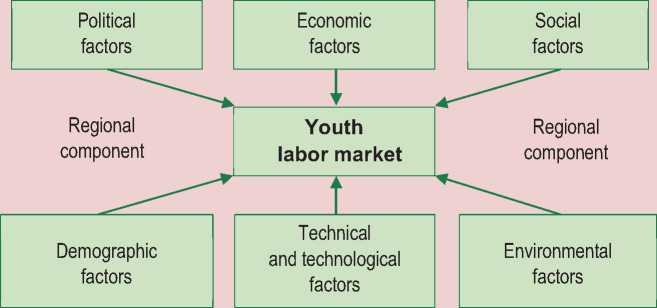
Source: compiled from results of author’s study of literary sources
The Russian labor market consists of a set of regional labor markets differing among themselves; each of them is formed and continues to function under the influence of a set of various factors ( Fig. 1 ). We believe that this leads to serious regional differentiation in terms of social and economic infrastructure development.
The consequences of financial issues caused by the current geopolitical situation could not but affect the country’s internal development. Despite their negative impact leading to stagnating economy, increased inflation and, as a result, to price increase, declined living standards of the majority of the population and unemployment, the infrastructure support of the youth labor market makes it possible to maintain an upward trend towards gradual increase in labor resources for various economic sectors.
Infrastructure support for the youth labor market. In economic literature there is no clear definition of “labor market infrastructure”, there is no efficient mechanism of infrastructure support for the development of the youth sector objectively adjusted depending on the impact of the above factors. The main objective of the labor market infrastructure is to ensure effective functioning of the employment sphere, providing all possible support to its subjects [18; 19]. The word “infrastructure” comes from two Latin words “infra” (below, under) and “structura” (structure, location). In relation to the labor market, the concept of “infrastructure” was first used by an American scientist P. Rosenstein-Rodan (1953) who considered it as “a set of general conditions ensuring favorable development of private entrepreneurship in main economic sector and meet the needs of the entire population” [20]. A similar definition of infrastructure is given by an economist G.Ya. Kiperman, who presents it as “a set of institutions ensuring adequate functioning of the market for goods, capital market and other markets” [21]. He believes that the infrastructure is designed to shape, regulate, and control the entire range of activities of market participants and contribute to their effective functioning.
The concept of “labor market infrastructure” is supplemented by its characteristic as promotion of employment and ensuring effective interaction of labor supply and demand [22]. Varfolomeeva O.A. interprets the concept as “a mechanism for regulating the demand and supply balance designed to provide economically favorable conditions for interaction between the subjects of the labor market infrastructure” [3]. All the abovementioned has served as a framework for the author’s definition of the labor market infrastructure, which we define as a complex of sectors of the national economy and state government bodies which are in close interaction and create conditions for effective functioning of both the economy in general and market entities.
It is obvious that in modern conditions the problem of youth employment, the identification of labor market imbalances and its correspondence to the technological, innovative, structural, and socio-economic development of both country’s and its regions’ economy is significant and require immediate solution. In this process the role of the labor market infrastructure is usually adjusted. On the one hand, it must meet the set requirements and, on the other hand, it must meet them and, in some cases, it must have an impact on the labor market throughout the country and its regions.
In Russia, the labor market infrastructure takes into account the peculiarities of the federal government and includes several levels: federal, sub-federal and municipal ( Fig. 2 ).
The labor market infrastructure includes institutions of vocational training and retraining, employment services and recruitment agencies. On the one hand, they provide conditions for individual’s labor realization on the market, on the other hand – they are a source of labor demand of a certain quality and quantity. We believe that this statement does not fully take into account all the areas of the state employment policy, implemented at the state level with the existing system of institutions designed to analyze and regulate
Figure 2. Levels of labor market infrastructure in Russia
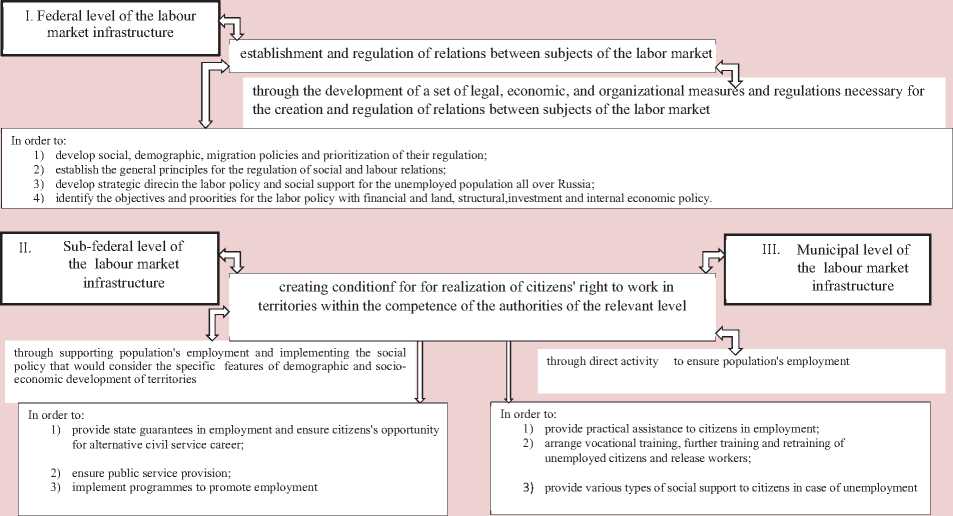
Source: compiled by: results of the author’s study of literary sources.
the state of the labor market at all government levels, contributing to the increase in human potential. The perfection of the labor market infrastructure with realizable objectives at each level determines the efficiency of the labor market as a whole. Changes in the jobs structure reflect, as mentioned above, the effects of a variety of factors.
However, taking into the current situation they can be supplemented by the following factors: the spread of new technology and the transition to production of new products, the development of modern forms of management and marketing strategies, increased competition at the national and international level, corporate restructuring, which is a distinctive feature of the regions related to the development of employment.
Research methodology. The purpose for the research is to analyze the state of the youth on the labor market and assess the measures of state support in the development of youth employment prospects.
The selection of methods is made based on an interdisciplinary approach and specifically for the purpose of studying the youth sector of the labor market. The combination of the following methods helps study the problem of the youth behavior on the labor market more comprehensively and objectively:
-
• Statistical information obtained from the Federal State Statistics Service database in the
field of labor and employment in Russia, the State Statistics Service of the Tyumen Oblast, Khanty-Mansi Autonomous Okrug (KhMAO) and Yamalo-Nenets Autonomous Okrug (YaNAO).
-
• Method of secondary data (results of the Russian Public Opinion Research Center (VTsIOM) study).
Discussion. As noted above, the peculiarities of the youth labor market functioning are largely determined by its regional development factors, which requires its analysis, forecasting and effective regulation. The authors chose the Tyumen Oblast – an economically prosperous region in the sphere of employment uniformly represented by type of economic activity – as a research object. The level of employment in the Tyumen Oblast excluding autonomous okrugs is 63.7%, in YaNAO – 74.5% and in KhMAO – 72.4%. They are rightly recognized as leaders in terms of employment, including among young people. The majority of the unemployed are young people with no education and low professional skills. As was mentioned earlier, age is a determining factor in the labor market. Today, the share of economically active youth in the region is about 30%.
Based in the specified constituent entities in the Tyumen Oblast ( Tab. 3 ) we consider in detail the process of the youth labor market formation and the process of infrastructure support in terms of youth employment.
Table 3. Demographic indicators of the youth in the Tyumen Oblast, people
|
Russia’s constituent entity |
2017 |
2018 |
||||
|
Population, thousand people |
Youth population, thousand people |
Share of youth, % |
Population, thousand people |
Youth population, thousand people |
Share of youth, % |
|
|
Tyumen Oblast (excluding autonomous okrugs) |
1477900 |
308050 |
21.1 |
1498800 |
336200 |
24.3 |
|
KhMAO |
1 646 078 |
477362 |
29.1 |
1 654 942 |
565990 |
34.2 |
|
YaNAO |
536000 |
133363 |
24.9 |
536 049 |
115 248 |
21.5 |
Source: compiled from: Rosstat demographic forecast up to 2030. Available at: http://www.
The economic focus of the region is formed under the influence of the fuel and energy complex development in Khanty-Mansiysk Autonomous Okrug – Yugra (hereinafter – KhMAO) and Yamalo-Nenets Autonomous Okrug (hereinafter – YaNAO). The industrial sector is represented by a wide range of industries providing jobs (Fig. 3).
Amid the declining number of those willing to study in i institutions of initial and secondary vocational education there is an increasing enterprises’ need for workers with various qualifications. This circumstance leads to imbalances in the provision of the labor market with skilled workers. The professional imbalance between labor demand and supply is the most pronounced in the South of the Tyumen Oblast ( Tab. 4 ).
According to the State Statistics Service of the Tyumen Oblast in 2016, a significant part of workers is in demand in construction (39.5%), real estate (11.6%), trade and public catering (9.2%) (Fig. 4). Unfortunately, about half of graduates from Tyumen educational institutions work outside their specialty.
When seeking employment, young people mostly use mass media (33%), informal channels: personal liaisons (38%), direct contact with employers (21%). It is worrying that employment services are the least effective channel in terms of job search (8.0%) ( Fig. 5 ).
Today, the share of young people who consider education as a value, rather than a means of achieving other goals has increased from 11 to 33%, while the indicators of youth employment and economic activity have declined slightly (from 65 to 50% and from 77 to 58%, respectively). Respondents state that they like their job (87%), while 2/3 of respondents are dissatisfied with their financial status: 61% rated it as average, 15% – bad, 16% consider their financial situation as good.
Figure 3. Forecast of staffing needs in the sector in the Tyumen Oblast, 2017
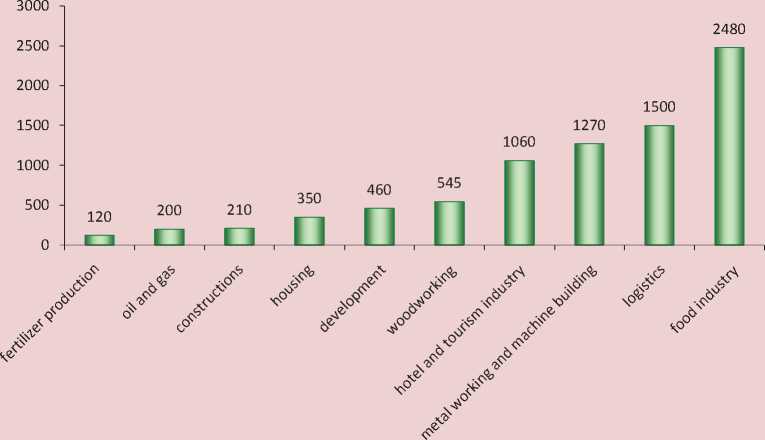
Source: compiled from data of the State Statistics Service of the Tyumen Oblast. Available at:
Table 4. Information on the situation in the labor market in municipal districts of the Tyumen Oblast, 2017, people
Municipal district f 5 ®" о о о g_S = Is § > 5 S E E 5 E о S 5 "5 и -S о E E о Abatsky District 9 058 274 61 73 205 0.67 Armizonsky District 5 002 141 35 193 107 0.70 Aromashevsky District 5 586 185 30 77 163 0.54 Berdyuzhsky District 5 631 174 33 86 135 0.59 Vagaysky District 9 673 148 51 116 121 0.53 Vikulovsky District 7309 281 20 116 253 0.27 Golyshmanovsky District 10 905 263 34 129 195 0.31 Zavodoukovsky 21 181 620 377 368 209 1.78 Ishim 36 077 724 227 572 347 0.63 Ishimsky District 15 216 288 97 174 133 0.64 Isetsky District 11 250 381 35 478 255 0.31 Kazansky District 11 419 600 214 291 360 1.87 Nizhnetavdinsky District 13 923 146 56 139 80 0.40 Omutinsky District 8 389 177 46 159 88 0.55 Sladkovsky District 4 964 125 29 95 90 0.58 Sorokinsky District 5 035 300 52 59 204 1.03 Tobolsk 54 826 1 206 390 6 696 651 0.71 Tobolsky District 9 729 325 69 174 209 0.71 Tyumen 445 960 4 832 2 855 9 486 3 161 0.64 Tyumensky District 62 033 995 520 1402 481 0.84 Uvatsky District 13 245 241 95 263 173 0.72 Uporovsky District 9 576 264 36 247 212 0.38 Yurginsky District 6 372 156 50 111 116 0.78 Yarkovsky District 10 349 275 81 175 199 0.78 Yalutorovsk 17 680 402 163 200 196 0.92 Yalutorovsky District 9 946 100 52 56 37 0.52 Source: compiled from Information of the Government of the Tyumen Oblast on the state of the labor market in municipal units of the Tyumen Oblast – 2017. Available at:
As can be seen, the majority of citizens today “are satisfied with the simple fact that they are employed”2.
At the same time, the studying youth is not willing to continue education, which makes it impossible for them to gain high professional skills and build a successful career. By number and quality of trained professionals for various economic sectors, the territory under review is one of the top ten regions of the country. The Oblast has a center for career guidance equipped with modern electronic simulators which help master the skills of electric and gas welding, excavating, driving, plumbing, the basics of 3D modeling. Last year it was visited by more than five thousand young people.
During economic recessions, the share of Tyumen enterprises providing training to their employees decreased, but the indicators of employee
Figure 4. List of vacancies declared at employment services in the Tyumen Oblast, 2017
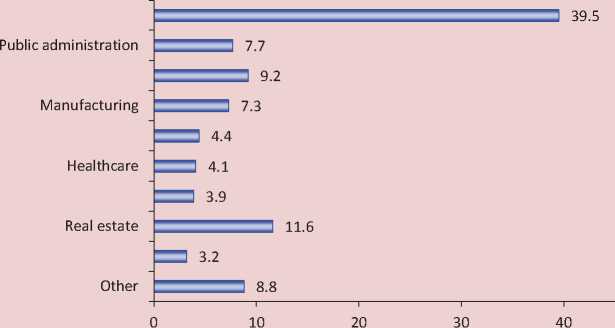
Source: compiled from data of the State Statistics Service of the Tyumen Oblast. Available at:
Figure 5. Informal youth employment channels in the region
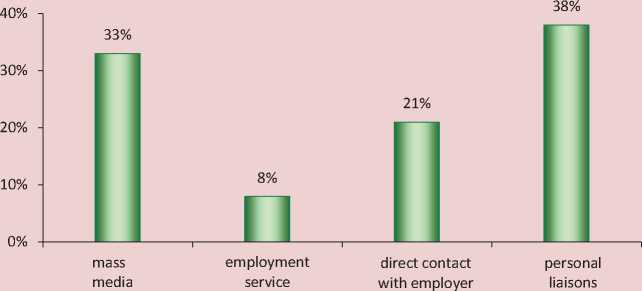
Source: based on the results of the author’s study of statistical data.
involvement in additional training programs have not changed. More than 80% of additional vocational training programs paid by employers are aimed at deepening the activities in the main specialty, while 52% of additional training programs – at retraining for a new specialty.
The entry of young people into the labor market in amid increased competition for jobs is a complex psychological process. In view of this fact, the Government of the Tyumen Oblast is closely engaged in youth employment, allocating funds for arranging additional jobs and training for new professions (Fig. 6).
Thanks to the undertaken measures the situation on the regional labor market is improving, which is confirmed by a decreasing level of officially recorded youth unemployment (0.7%). This is a consequence of active work of regional authorities on allocating funds to support the youth labor market, opening production facilities with quota allocation on jobs for young professionals.
In this context, the experience of KhMAO and YaNAO, where 2/3 of the population are employed in the fuel and energy complex, is interesting. The governments of autonomous okrugs are considering a variety of areas of economic development, in particular the development of forestry and agro-industrial complex, medicine, small and medium business development.
The peculiarity of these okrugs is the age structure of the employed population. In KhMAO, the majority of men with higher education employed in the industrial sector are between 26 and 30 and women – between 26 and 28, which indicates the predominance of young ages in the region’s economy. Table 5 presents the performance of labor needs forecast for sectoral employment in KhMAO.
Based on data from Table 5, the authors identify the need for personnel in technical specialties, especially with higher professional education. In 2016, the target figures of admission to higher education institutions were distributed according to the mediumterm forecast of the district’s labor needs. The share of students enrolled in higher education institutions comprised 37%, in institutions of secondary vocational education – 63%. The enrollment for the 2016/2017 academic year in the universities include 1,057 people financed
Figure 6. State of the labor market in the Tyumen Oblast, people
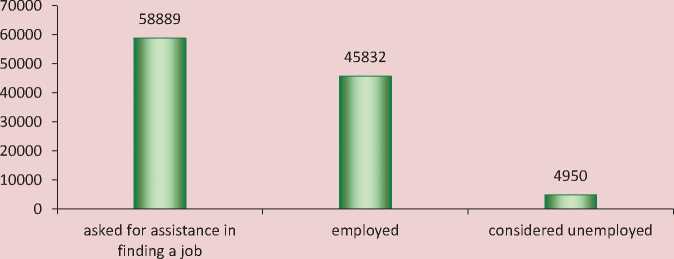
Source: compiled from data of the State Statistics Service of the Tyumen Oblast. Available at:
Figure 7. Structure of the unemployed youth by period of job search, %
|
2010 |
31.8 |
27.3 |
20 |
10.6 |
10.4 |
lessthan 1 month |
|
1-3 months |
||||||
|
2014 |
30.2 |
32.3 |
14.7 |
14 |
8.8 |
|
|
3-6 months |
||||||
|
2015 |
30.6 |
32.1 |
14.5 |
13.7 |
9.1 |
6-12 months |
|
12 months and over |
||||||
|
2016 |
32.5 |
30.7 |
16.4 |
11.4 |
9 |
Source: compiled from data of the State Statistics Service of the Tyumen Oblast. Available at: by the budget of the Russian Federation and 2594 people financed by the budget of the Autonomous okrug. The projected number of students of institutions of higher education by 2019 will account for 35.7 thousand people. It is planned to introduce an applied component in the system of scientific knowledge. The relevant training areas are applied geology; ground transport machinery and technology; electrical and heat power engineering; technosphere safety; electronics, radio engineering and communications systems; materials technology, etc. By 2020, it is expected to launch 24 additional programs at different levels of professional training of young people.
5,705 people were admitted to institutions of secondary vocational education at the expense of the budget of the autonomous okrug, 600 people – at the expense of the budget of the Russian Federation (branches of Yugra State University), which confirms increased attention to training through the implementation of educational programs in secondary vocational education. In order to meet the need for skilled personnel, there are two multifunctional applied skills centers. Six resource centers simultaneously provide network interaction with the enterprises of the Okrug. But even this, according to the authors, will not fully meet the labor needs in terms of territory’s strategic development.
A similar socio-economic situation is in YaNAO. The registered unemployment rate is not high (0.91%). In order to ensure state guarantees to promote the realization of citizens’ rights to productive and freely chosen employment, the state program “Promoting employment for 2014–2020” approved by the Government of the autonomous okrug in December 25th, 2013, is being successfully implemented. According to Governor D. Kobylkin, “the okrug’s sector specialization has a direct impact on the structure of the labor market”. The head of the Arctic region highlighted the main feature of the territory – a shortage of highly qualified specialists and workers. As of January 1st, 2017, 10,356 vacancies have been registered in the regional
Table 5. Labor needs forecast for sectoral employment by type of economic activity in KhMAO, people
|
Type of economic activity |
2016 |
2017 |
2018 |
2019 |
2020 |
|||||
|
о ± |
8 О ° 8 "О ^ |
о ± |
8 о ° 8 "О ^ |
о ± |
8 о ° 8 "О ^ (% "4= |
о ± |
8 о ° 8 "О ^ |
о ± |
8 о ° 8 "О ^ |
|
|
Mineral extraction |
116 |
680 |
192 |
1174 |
303 |
2120 |
454 |
3289 |
742 |
4599 |
|
Manufacturing |
82 |
157 |
133 |
242 |
200 |
410 |
285 |
621 |
421 |
865 |
|
Education |
41 |
91 |
83 |
146 |
141 |
243 |
220 |
516 |
366 |
938 |
|
Healthcare |
31 |
320 |
97 |
558 |
192 |
1117 |
323 |
1778 |
632 |
2500 |
|
Public administration |
98 |
147 |
179 |
241 |
286 |
411 |
424 |
669 |
654 |
1006 |
|
Finance |
17 |
26 |
26 |
44 |
37 |
81 |
56 |
128 |
79 |
184 |
|
Real estate |
154 |
105 |
263 |
168 |
415 |
311 |
616 |
518 |
914 |
788 |
|
Hotels and restaurants |
7 |
10 |
7 |
13 |
9 |
18 |
11 |
30 |
12 |
46 |
|
Housing |
35 |
31 |
61 |
47 |
87 |
79 |
125 |
133 |
192 |
214 |
|
Construction |
36 |
111 |
56 |
176 |
90 |
418 |
139 |
741 |
224 |
1097 |
|
Transport and communication |
104 |
340 |
169 |
532 |
259 |
922 |
378 |
1403 |
554 |
1947 |
|
Trade |
35 |
104 |
62 |
178 |
100 |
333 |
147 |
523 |
217 |
764 |
|
Agriculture and fishery |
11 |
12 |
12 |
14 |
12 |
18 |
13 |
26 |
13 |
34 |
Source: compiled from the Federal Stater Statistics Service for KhMAO. Available at:
Table 6. Main share of reported vacancies in YaNAO, %
Type of economic activity 2015 2016 2017 Construction 52.2 64.4 57.8 Public administration 4.2 2.9 10.5 Mineral extraction 5.0 2.7 5.3 Manufacturing 3.3 2.3 1.5 Trade 2.0 2.6 1.6 Research and technical work 0 0 2.4 Healthcare 5.8 2.9 3.5 Education 7.2 5.8 5.4 Transport 6.8 4.4 4.4 Agriculture and fisheries 0.7 1.1 0.8 Housing 3.9 4.6 2.2 Real estate 4.6 3.6 3.2 Hotel and restaurant business 1.1 0.9 0.4 Finance 0.6 0.3 1.0 Source: compiled from data of the Federal State Statistics Service in YaNAO. Available at: bank of vacancies, 63.6% of which are bluecollar jobs (Tab. 6). The most demanded jobs are construction workers, medical workers of different specialization, teachers, etc.
The number of unemployed young people aged 16–29 comprises 902 people, or 31.3%. In YaNAO, the problem of employment among young professionals is solved by direct district support: when young professionals are employed, enterprises are compensated from the district budget for salary costs in the amount of two times minimum wage. This helps young specialists gain a foothold in an enterprise.
In order to replenish the youth labor market with workers, tregional authorities are implementing measures to re-focus young people to get blue-collar jobs. In the district there are three research-and-education complexes of vocational education and six colleges training high-skilled workers. Specialized classes from Gazprom and Rosneft have been established in educational institutions of the district. Therefore, it can be stated that research-and-education centers contribute to the formation of a single infrastructure to eliminate imbalances in the youth labor market thereby ensuring the implementation of investment projects in the territory of Yamal, in particular the project of the Ural Federal District “Industrial Ural – Polar Ural”.
Conclusion. The authors’ analysis has shown that the problems mainly lie in the following spheres: economic, financial, staffing, etc. This situation is generated as a result of imbalance between demand and supply on the labor market, lack of high- and medium-skilled specialists, and the enterprises’ need for skilled and unskilled labor. The development of the territory’s industrial potential imposes certain requirements on the quantitative and qualitative composition of the labor force, which, on the one hand, as practice shows, is difficult to satisfy using the existing regulation mechanisms, on the other hand, is impossible to satisfy without due attention to the youth sector from labor market institutions.
In order for the change of the essence of effective labor realization of young people to have a positive result, it is necessary to reconsider the system of labor market monitoring, which would change the system of interaction of subjects of the institutional structure of the labor market ( Fig. 8 ). Quality monitoring of the labor market will become the framework for obtaining information that would contribute to effective regulation of the regional youth labor market, its subjects would be able to effectively adjust their policies regarding the quantity and quality of labor resources. Providing objective information on the structure of existing jobs will become the basis of professional motivation and formation of appropriate behavior of potential employees on the labor market.
Thus, the formation of the youth labor market in the Tyumen Oblast will contribute to productive employment, which is a derivative of an effectively functioning flexible labor market. This will make it possible to respond
Figure 8. Changes in interaction between the subjects of the institutional structure of the labor market in the Tyumen Oblast
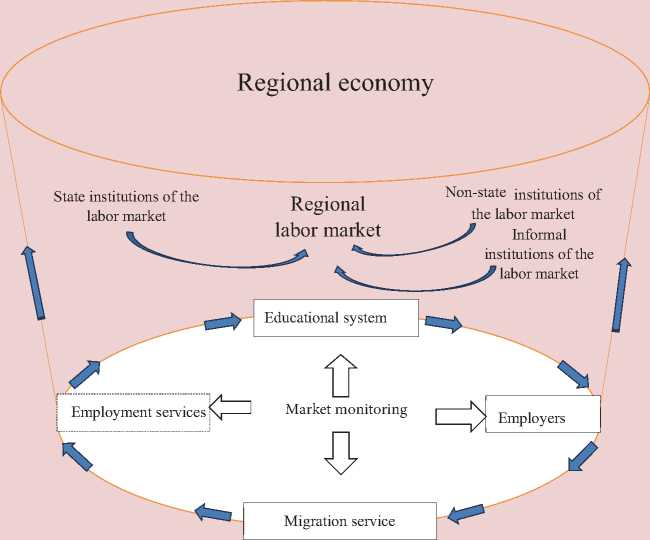
Source: based on the research results.
quickly to changes in the current structure of employment, including youth employment, reduction in inefficient jobs, and redistribution of workers by economic industry-specific sectors, the development of innovative areas of employment.
Список литературы The infrastructure support for the development of the youth sector in the regional labor market
- Kolesnik E.A. Revisiting the role of modern institutions in forming the youth sector of the labor market. Vestnik Tyumenskogo gosudarstvennogo universiteta. Sotsial'no-ekonomicheskie i pravovye issledovaniya=Tyumen State University Herald. Social, Economic, and Law Research, 2015, vol. 1, no. 4(4), pp. 190-199..
- Osipova L.B., Enveri L.A. Life strategies of young people: sociological research experience. Ekonomicheskie i sotsial'nye peremeny: fakty, tendentsii, prognoz=Economic and Social Changes: Facts, Trends, Forecast, 2016, no. 4 (46), pp. 108-129..
- Main areas of activities of the Government of the Russian Federation up to 2018. Available at: http://base.garant.ru/70309020
- Varfolomeeva O.A. Molodezh' na rynke truda: Nauchnaya sessiya professorsko-prepodavatel'skogo sostava, nauchnykh sotrudnikov i aspirantov po itogam NIR 2005 goda: sbornik dokladov . Saint Petersburg: Izd-vo SPbUEF, 2005. Pp. 52-56.
- Gaisina L.M., Bakhtizin R.N., Mikhaylovskaya I.M., Khairullina N.G., Belonozhko M.L. Social technologies as an instrument for the modernization of social space in the social and labor sphere. Biosciences Biotechnology Research Asia, 2015, vol. 12, no. 3, pp. 2947-2958.
- Bourdieu P. Forms of Capital. The Sociology of Economic Life. P: Westview Press, 2001, 344p.
- Kolesnik E.A. Importozameshchenie: funktsionirovanie i razvitie rynka truda regiona . Tyumen': TIU, 2017. 167 p.
- Agabekyan R.L. Russian labor market: features, problems and prospects: monograph. Krasnodar: Publishing-house -South, 2014, 208 p.
- Ilyshev A. Demographic program: priorities and implementation mechanism. Ekonomist=Economist, 2008, no. 6, pp. 46-52..
- Gaisina L.M., Bakhtizin R.N., Mikhaylovskaya I.M., Khairullina N.G., Belonozhko M.L. Sociological evaluation of effectiveness of labor workers' behavior. Biosciences Biotechnology Research Asia, 2015, vol. 12, no. 3, pp. 3091-3100.
- Kislyakov P., ShmelevaE., SilaevaO., Belyakova N., Kartashev V. Indices of socio-emotional wellbeing of youth: evaluation and directions of improvement. Available at: https://www.shs-conferences.org/articles/shsconf/ref/2016/06. DOI: https://doi.org/10.1051/shsconf/20162801056
- Krinitcyna Z.V., Menshikova E.V. Discrimination Issues in the Process of Personnel Selection. Procedia. Social and Behavioral Sciences, 2015, vol. 166, pp. 12-17.
- Labor and employment in Russia: statistics book. Rosstat. Moscow, 2017. 261 p.
- Tavokin E.P. Russian youth in the labor market in the expert assessments. Monitoring obshchestvennogo mneniya=The monitoring of public opinion: economic and social changes journal, 2016, no. 2 (132), p. 176..
- Krivutsa P.V. Osobennosti obespecheniya zanyatosti molodezhi v usloviyakh rynochnoi ekonomiki: avtoref. dis. … kand. ekon. nauk: 08.00.05 . December 18th, 2008. Moscow, 2008. P. 13.
- Tsygankova I.V. Kachestvo trudovoi zhizni molodezhi Rossii: kontseptual'nye osnovy formirovaniya: avtoref. dis. … dok. ekon. nauk: 08.00.05 . March, 12th, 2009. Moscow, 2009. P. 30.
- Il'inskii I.M. Molodezh' i molodezhnaya politika. Filosofiya. Istoriya. Teoriya . Moscow: Golos, 2007. P. 100.
- Alekseev M.S. Sovershenstvovanie rynochnoi infrastruktury v usloviyakh perekhodnogo protsessa . Proceedings of the Research Conference "XXI century -development of social institutions in Russian". Moscow, 2007. Pp. 72-73.
- Zbyshko B.G. Regulirovanie sotsial'no-trudovykh otnoshenii v Rossii (mezhdunarodnyi i natsional'nyi aspekt) . Moscow: "Sotsial'noe strakhovanie", 2004. 392 p.
- Rosenstein-Rodan P. The Notes of theory of the «Big Puc» in economic development for Latin America. London-N.Y, 1961, pp. 29-42.
- Kiperman G.Ya. (Ed.). Rynochnaya ekonomika: slovar' . Moscow: Respublika, 1993. Pp. 183-184.
- Alekseev M.S. Sovershenstvovanie rynochnoi infrastruktury v usloviyakh perekhodnogo protsessa . Proceedings of the Research Conference "XXI century -development of social institutions in Russian". Moscow, 2007. Pp. 72-73.

